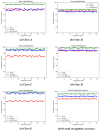Underwater acoustic target recognition method based on a joint neural network
- PMID: 35486577
- PMCID: PMC9053803
- DOI: 10.1371/journal.pone.0266425
Underwater acoustic target recognition method based on a joint neural network
Abstract
To improve the recognition accuracy of underwater acoustic targets by artificial neural network, this study presents a new recognition method that integrates a one-dimensional convolutional neural network and a long short-term memory network. This new network framework is constructed and applied to underwater acoustic target recognition for the first time. Ship acoustic data are used as input to evaluate the network performance. A visual analysis of the recognition results is performed. The results show that this method can realize the recognition and classification of underwater acoustic targets. Compared with a single neural network, the relevant indices, such as the recognition accuracy of the joint network are considerably higher. This provides a new direction for the application of deep learning in the field of underwater acoustic target recognition.
Conflict of interest statement
The authors have declared that no competing interests exist.
Figures












Similar articles
-
Underwater acoustic target recognition using attention-based deep neural network.JASA Express Lett. 2021 Oct;1(10):106001. doi: 10.1121/10.0006299. JASA Express Lett. 2021. PMID: 36154215
-
Underwater single-channel acoustic signal multitarget recognition using convolutional neural networks.J Acoust Soc Am. 2022 Mar;151(3):2245. doi: 10.1121/10.0009852. J Acoust Soc Am. 2022. PMID: 35364907
-
Underwater Target Signal Classification Using the Hybrid Routing Neural Network.Sensors (Basel). 2021 Nov 24;21(23):7799. doi: 10.3390/s21237799. Sensors (Basel). 2021. PMID: 34883803 Free PMC article.
-
A Survey of Underwater Acoustic Data Classification Methods Using Deep Learning for Shoreline Surveillance.Sensors (Basel). 2022 Mar 11;22(6):2181. doi: 10.3390/s22062181. Sensors (Basel). 2022. PMID: 35336352 Free PMC article. Review.
-
Analysis of Gastrointestinal Acoustic Activity Using Deep Neural Networks.Sensors (Basel). 2021 Nov 16;21(22):7602. doi: 10.3390/s21227602. Sensors (Basel). 2021. PMID: 34833679 Free PMC article.
Cited by
-
An efficient deep learning approach with frequency and channel optimization for underwater acoustic target recognition.Sci Rep. 2025 Jul 28;15(1):27369. doi: 10.1038/s41598-025-12452-2. Sci Rep. 2025. PMID: 40717158 Free PMC article.
-
A Novel Underwater Acoustic Target Recognition Method Based on MFCC and RACNN.Sensors (Basel). 2024 Jan 2;24(1):273. doi: 10.3390/s24010273. Sensors (Basel). 2024. PMID: 38203134 Free PMC article.
References
-
- Zhou XY, Yang KD and Duan R. Deep Learning Based on Striation Images for Underwater and Surface Target Classification. IEEE Signal Processing Letters. 2019;26(9): 1378–1382.
-
- Chandran CS, Kamal S, Mujeeb A and Supriya MH. Passive Sonar Target Classification Using Deep Generative beta-VAE. IEEE Signal Processing Letters. 2021; 28: 808–812.
-
- Kaplun D, Voznesensky A, Romanov S, Andreev V and Butusov D. Classification of Hydroacoustic Signals Based on Harmonic Wavelets and a Deep Learning Artificial Intelligence System. Applied Sciences-Basel. 2020;10(9).
-
- Neupane D and Seok J. A Review on Deep Learning-Based Approaches for Automatic Sonar Target Recognition. Electronics. 2020; 9(11).
Publication types
MeSH terms
LinkOut - more resources
Full Text Sources

